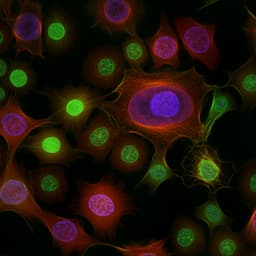
Physics
Non-Hermitian dynamics and non-reciprocity of optically coupled nanoparticles
M. Reisenbauer, H. Rudolph, et al.
This groundbreaking research investigates the non-Hermitian dynamics of optically coupled nanoparticles, revealing fascinating phenomena such as parity-time symmetry breaking and a stunning mechanical lasing transition. The team, including authors from the Vienna Center for Quantum Science and Technology and the University of Duisburg-Essen, delves into controllable multi-particle effects, paving the way for exciting advancements in quantum technology.
~3 min • Beginner • English
Introduction
The study addresses how non-reciprocal, non-Hermitian interactions shape collective dynamics of coupled mechanical oscillators realized by optically levitated nanoparticles. While many physical systems are described by Hermitian dynamics, increasing complexity, environmental coupling, and chiral transport necessitate non-Hermitian models. Non-reciprocal interactions, which effectively violate action-reaction symmetry, are widespread and enable unidirectional or topological transport and enhanced sensing. Levitated nanoparticles in tweezer arrays provide tuneable long-range optical interactions and single-site readout, offering a controlled platform to probe non-Hermitian physics. The research question is whether two optically trapped nanoparticles with engineered anti-reciprocal, nonlinear dipole-dipole interactions exhibit PT-symmetry breaking and nonlinear phases such as limit-cycle (mechanical lasing) dynamics, and how these phases manifest in spectra, damping rates, correlations, and phase relations.
Literature Review
Non-Hermitian and PT-symmetric physics has been explored across photonics, ultracold atoms, electrical circuits, and metamaterials, demonstrating phenomena such as exceptional points, topological effects, and enhanced sensing. Prior works include PT-symmetry breaking in optics, non-Hermitian bulk-boundary correspondence, and exceptional-point physics. In optomechanics and related platforms, synthetic gauge fields, topological energy transfer around EPs, and phonon lasing have been reported. Levitated optomechanics has advanced from single-particle control to arrays with tunable light-induced dipole-dipole interactions, enabling scalable architectures. Recent experiments showed non-reciprocal optical interactions and cold damping in levitated arrays, providing the basis for engineering reciprocal and anti-reciprocal couplings. Theory predicts enhanced sensing and topological states in non-reciprocal lattices. This work builds on these developments to realize and characterize PT phases and nonlinear limit cycles in a minimal two-particle system with dynamically tunable anti-reciprocal optical binding.
Methodology
Experimental platform: Two silica nanoparticles (nominal radius r = 105 ± 2 nm) are trapped in optical tweezers generated by a 1,064 nm laser and two orthogonal acousto-optic deflectors (AOD-x/y) driven by RF tones at ω1 and ω1 + Δω to form 2 × 2 beams. A slit selects beams with equal optical frequency; a Dove prism rotates the beam plane to the table. A high-NA (0.77) lens focuses the beams to two foci separated by distance d0 ≈ 18.4 μm, tunable via Δω (calibrated conversion C0 = 2.3845 ± 0.0005 μm MHz−1). Optical phases at the traps φ1,2 are set by RF phases; polarization angle θ is set with a half-wave plate. Typical trap powers P1,2 ≈ 0.3 W yield CoM axial frequencies Ω1,2 ≈ 2π × 27.5 kHz. Mechanical detuning ΔΩ = Ω2 − Ω1 is swept by adjusting P1,2 symmetrically at fixed total power. Gas damping is maintained at γ/2π = 0.46 ± 0.02 kHz. Electrostatic coupling is minimized by plasma discharging; residual charges q1 = 2.5 ± 0.7 e, q2 = 1.5 ± 0.5 e produce negligible coupling gc = −0.077 ± 0.030 Hz. Particle sizes are verified approximately equal by pressure-dependent damping ratio measurements (γ1/γ2 = 0.99 ± 0.01). Detection: Back-scattered light is separated with a Faraday rotator and PBS, and each particle is monitored independently via fiber-based confocal microscopes and balanced heterodyne detection with a local oscillator (ωLO/2π ≈ 1.1 MHz). The optical phase encodes axial motion; z(t) is extracted by Hilbert-transform demodulation, using φ(z) ≈ 2kz (Gouy phase correction ≈ −3% is neglected). The complex amplitude of motion a_j(t) is constructed to compute phases and correlations. Coupling engineering and calibration: The reciprocal (gr) and anti-reciprocal (ga) optical binding rates depend on d0 and optical phase difference Δφ = φ2 − φ1 as gr = G cos(kd0) cos(Δφ/kd0) and ga = G sin(kd0) sin(Δφ/kd0), with G ∝ P1 P2 cos^2 θ. Parameters are scanned to maximize ga and minimize gr; normal-mode attraction without frequency splitting confirms predominantly anti-reciprocal coupling with Δφ ≈ (0.5 ± 0.08)π and d0 = 18.408 ± 0.005 μm, yielding gr ≈ 0 within uncertainty. Anti-reciprocal coupling magnitude ga (denoted g) is extracted by fitting eigenfrequency differences vs ΔΩ from PSDs; g follows cos^2 θ. Linear non-Hermitian model: In a frame rotating at Ω0 = (Ω1 + Ω2)/2, linearized, period-averaged equations yield d/dt[a1 a2]^T = −i HNH [a1 a2]^T + √(γ ħ/τ) ξ, with HNH = [ ΔΩ/2 −i(gr+ga); −i(gr−ga) −ΔΩ/2 ] − i(γ/2) I. Eigenvalues λ± = −iγ/2 ± √(ΔΩ^2 − 4 ga ΔΩ + gr^2)/2 determine eigenfrequencies Ω± = ±Re(λ±) and damping γ± = −2 Im(λ±). Exceptional points occur at ΔΩEP1,2 = ±2 ga ± 2 gr. Between EPs, normal-mode attraction manifests as degenerate frequencies and split damping rates (max split ≈ 4g for gr ≈ 0). Correlation functions are computed from the linear model; in the PT-broken regime oscillatory correlations change to bi-exponential decay. Nonlinear model and limit cycle: When the effective damping γ+ < 0, amplitudes grow and the linear theory fails. A nonlinear theory including the full optical binding nonlinearity (function f(x) = 2 J1(x)/x) but neglecting thermal noise yields dynamical equations for collective amplitude A and inter-oscillator phase φ in the PT-broken regime. Two steady-state solutions arise: (1) a correlated thermal-like state with A = 0 and φ = 2 arcsin(ΔΩ/4g), and (2) a stable limit cycle with nonzero A satisfying f(A ΔΩ/√(γ^2 + ΔΩ^2)) = (γ^2 + ΔΩ^2)/(4 g ΔΩ) and φ = 2 arctan(ΔΩ/γ). The transition occurs via a Hopf bifurcation at the threshold g = (γ^2 + ΔΩ^2)/(4 ΔΩ). Data analysis: Instantaneous phases φj are extracted via Hilbert transforms; phase delay φ = φ2 − φ1 and its histogram determine preferred phase φmax. Displacement envelopes |zj| are modeled with Rayleigh (A=0) or Rice (A>0) distributions to extract individual Aj and the collective amplitude Ā ∝ √(A1^2 + A2^2); near threshold, bimodal Rice mixtures account for intermittency due to thermal drifts. Autocorrelation and cross-correlation functions g(Δt) are computed and compared with theory to identify PT phases.
Key Findings
- Tunable anti-reciprocal optical coupling between two levitated nanoparticles enables exploration of non-Hermitian dynamics with minimal reciprocal component (gr ≈ 0). The anti-reciprocal rate g scales as cos^2 θ with tweezer polarization.
- PT-symmetry breaking and exceptional points: Between two EPs, eigenfrequencies coalesce and damping rates split by up to ≈ 4g, evidencing normal-mode attraction. For a representative dataset with g/γ = 0.58 ± 0.05, the PT-broken region spans 0 ≤ ΔΩ/γ ≤ 2.3.
- Correlated motion and phase locking in the PT-broken phase: The two particles develop a preferred, stable phase delay φmax, transitioning from uniform phase differences (uncoupled) to strongly peaked histograms; joint z1–z2 distributions evolve from uncorrelated Gaussian to tilted correlated ellipses.
- Nonlinear Hopf bifurcation to a limit cycle (mechanical lasing): When γ+ becomes negative, intrinsic nonlinearity of the optical binding stabilizes a self-sustained oscillation (limit cycle). The threshold condition from nonlinear theory g = (γ^2 + ΔΩ^2)/(4 ΔΩ) is observed experimentally. At ΔΩ/γ = 0.9, a nonzero collective amplitude A emerges at g/γ ≈ 0.5 and grows approximately as a square root of (g − gth), matching theory.
- Sideband interference picture: Anti-reciprocal coupling interferometrically suppresses either Stokes or anti-Stokes scattering for the two eigenmodes, producing, respectively, an amplified and a damped mechanical mode; lasing occurs when amplification exceeds intrinsic loss.
- Experimental parameters and controls: Gas damping fixed at γ/2π = 0.46 ± 0.02 kHz; axial frequencies ≈ 27.5 kHz; particle spacing d0 = 18.408 ± 0.005 μm; residual electrostatic coupling negligible (gc ≈ −0.077 ± 0.030 Hz). Reconstructed eigenmodes and spectrograms quantitatively agree with linear theory outside the nonlinear regime; nonlinear amplitudes and phase evolution agree with the derived model, with minor discrepancies attributed to thermal fluctuations not included in the nonlinear theory.
Discussion
The results demonstrate that two optically levitated nanoparticles with engineered anti-reciprocal coupling realize a minimal non-Hermitian mechanical system exhibiting PT-symmetry breaking and a nonlinear mechanical lasing transition. The PT-broken regime is identified by degenerate eigenfrequencies and split damping rates, normal-mode attraction, correlated motion, and a stable inter-oscillator phase. As the anti-reciprocal coupling increases, the system crosses a Hopf bifurcation where the effective gain overcomes intrinsic damping, leading to a stable limit cycle whose amplitude follows the nonlinear theory. The interference-based suppression of mechanical sidebands provides a clear physical mechanism for gain and loss without optical cavities, distinct from Purcell-enhanced schemes. These findings directly address the research question by mapping the linear and nonlinear non-Hermitian phases in a controllable platform with single-site readout, establishing levitated arrays as promising testbeds for non-equilibrium and topological non-Hermitian phenomena, enhanced sensing near EPs, and programmable transport in larger lattices.
Conclusion
The study establishes a levitated optomechanical platform with tuneable anti-reciprocal optical interactions that exhibits PT-symmetry breaking and a transition to mechanical lasing via a Hopf bifurcation. Single-particle readout enables reconstruction of eigenmodes and direct observation of normal-mode attraction, damping-rate splitting, correlated motion, and phase locking. The nonlinear limit-cycle dynamics are accurately described by a theory that captures the intrinsic nonlinearity of optical binding. This platform paves the way for dynamical protocols such as EP encircling for topological energy transfer, exploration of non-reciprocal phase transitions and non-equilibrium steady states in larger arrays, and sensing applications leveraging non-Hermitian amplification. Future work could extend to multi-particle lattices with spatially programmable reciprocity, investigate quantum regimes with ground-state cooled motion or limit-cycle fluctuation cooling, and pursue quantum optical binding and long-range entanglement with non-Hermitian control.
Limitations
- The nonlinear theory for the limit cycle neglects thermal fluctuations, which likely cause observed deviations in amplitude and intermittent bimodality near threshold due to slow drifts of mechanical frequencies.
- The system involves only two oscillators and lacks an apparent thermodynamic limit; interpreting the lasing transition as a phase transition is thus in a finite, minimal system.
- Small residual mass or damping asymmetries and thermal noise lead to nonzero frequency differences within the PT-broken regime not captured by the simplest linear model.
- Assumptions of equal particle size and spherical symmetry are approximately met but not exact; nonetheless, measured size and damping ratios are within 1%.
- Optical potential nonlinearities are neglected in the effective limit-cycle model (their influence cancels for equal amplitudes), and Gouy phase corrections are small and ignored in the main analysis.
- Results are obtained at finite gas pressure with fixed damping; extension to ultra-high vacuum or quantum-limited regimes may require additional control.
Related Publications
Explore these studies to deepen your understanding of the subject.







